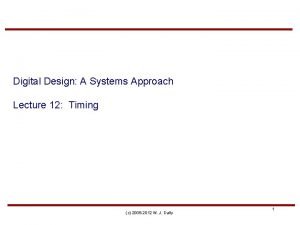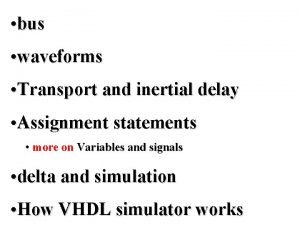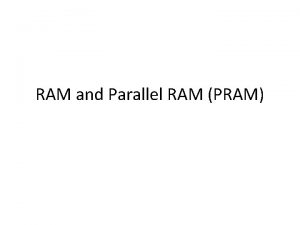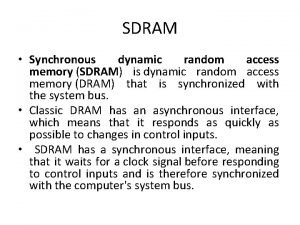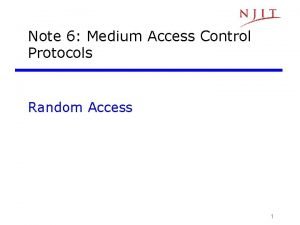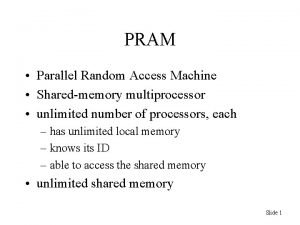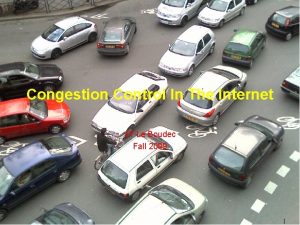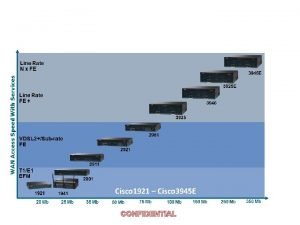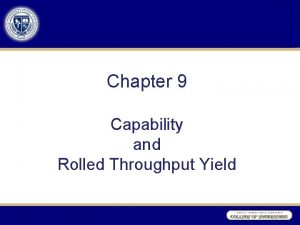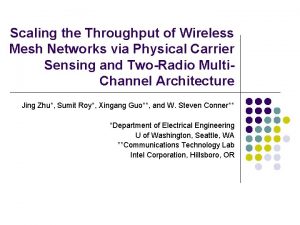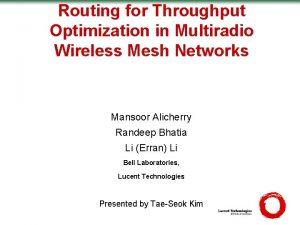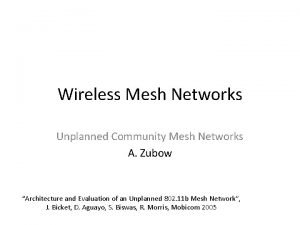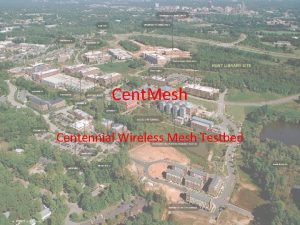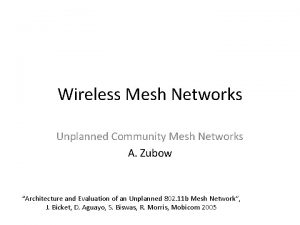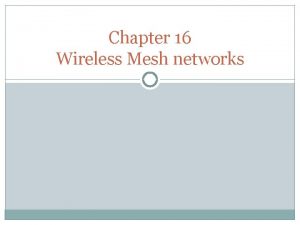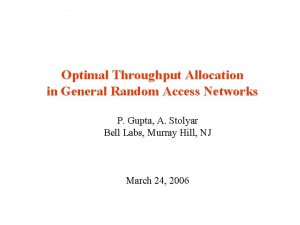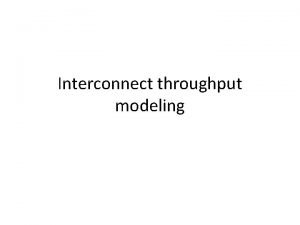Delay and Throughput in Random Access Wireless Mesh























- Slides: 23

Delay and Throughput in Random Access Wireless Mesh Networks Nabhendra Bisnik, Alhussein Abouzeid ECSE Department Rensselaer Polytechnic Institute (RPI)

Wireless Mesh Networks (WMNs) q WMNs are becoming increasingly popular for providing connectivity among communities q Consists of mesh clients and mesh routers q Mesh clients: devices that require connectivity q Mesh routers: form backbone of WMN q Compared to ad hoc networks, WMNs have infrastructure in form of mesh routers hence better performance is expected q Examples: Seattle. Wireless, MIT Roofnet, Wireless Philadelphia, So. Cal. Free. Net

Mesh Routers q Compared to mesh clients, the routers have enhanced features like larger transmission range, ability to communication on multiple channels q When a mesh client needs to communicate with another client or gateway, it forwards the packet to its assigned mesh router q Packet is then forwarded along the mesh router backbone until it reaches a router that is near the destination

A wireless mesh network

Motivation q Design of WMN governed q Mesh client density q Available budget q Required bit rate q Expected traffic pattern by q Size and budget of WMN may vary q MIT Roofnet – few clients, low budget q Wireless Philadelphia – thousands of clients, huge budget q Attempt to answer questions like: q What bit rate achievable if m routers with l available channels deployed to serve n clients? q How many clients can m routers with n available channels server so that desired bit rate is achievable? q What end-to-end delay to expect for a given implementation?

Delay in WMNs q Queuing delay depends on q Packet arrival process – How much traffic is handled by network? q Mesh router density – How many clients does a router serve? q MAC protocol – How the channel is shared among routers? q Traffic pattern – how many times a packet is forwarded over the router backbone before it reaches destination? q End-to-end delay is sum of queuing and transmission delays at mesh routers q Modeling all the factors is quite challenging

Throughput in WMNs Maximum achievable per node throughput of a WMN is the maximum rate at which the clients of the network may generate traffic while keeping delay finite q Maximum achievable throughput is inversely proportional to q q Average time a router takes to serve a packet q Average number of flows served by the routers

Our Approach Model multihop mesh networks as queueing networks q Use Diffusion approximation method to evaluate closed form expressions of service time and endto-end packet delay q Use the expressions of service time and delay to evaluate maximum achievable throughput q

WMN Model An urban neighborhood – Typical location for WMN deployment

WMN Model A common approach is to install one mesh router for each block

WMN Model So a mesh network may be viewed as collection of disjoint cell, each having a mesh Router for serving clients within the cell

Mesh Model qn mesh clients are uniformly and independently over a unit torus q The torus is divided into disjoint identical cells of are a(n) each, such that there are m = 1/a(n) cells q Each router can communicate with routers of neighboring cells q Each mesh router can hear on all available channels (l channels), transmits on the particular channel allocated to it. q All two hops neighbors transmitting on the same channel are interfering neighbors

For example, IEEE 802. 11 allows transmission on three orthogonal channels Routers transmitting on channel 1 Routers transmitting on channel 2 Routers transmitting on channel 3

Router A Since routers transmit at different channels, number of interfering neighbors of Router A reduced to 8 Potential interferers of Router A = 24 Routers Thus number of interfering neighbors (I) of a mesh router is a function of cell geometry and the number of available channels/interfaces

Traffic Model client produces packets of length L at rate packets/sec q As soon as a packet arrives at a client, it is assumed to be transferred to the corresponding server ) no delay at clients q When a router receives a packet from a neighbors q Each The packet belongs to a clients within its cell with probability p(n) (absorption probability) q The packet is forwarded to a randomly chosen neighbor with probability 1 – p(n) q q That is, the fraction of packets received by a router that are destined to its cell equals p(n) characterizes the degree of locality of traffic – Low p(n) ) average number of hops between a source destination pair is large

MAC Model q Before transmitting a packet each router counts down a random timer q The duration of the time is exponentially distributed with mean 1/ q Once the timer of a router expires it starts transmitting and at the same instant the timers of all interfering neighbors is frozen q The frozen timers are resumed as soon as the current transmission finishes The MAC model captures the collision avoidance mechanism of IEEE 802. 11 and is still mathematically tractable

Queuing Model Router D Router E Router C Router A Router B Filter for absorbing packets destined to its cell G/G/1 queuing network Each station of the queuing network represents a mesh router. Diffusion approximation is used to solve the queuing network

Service Time Result q Average service time of a mesh router Service time in absence of interference Fraction of time the channel is busy

Service Time Result q Average end-to-end packet delay

Maximum Achievable Throughput q Maximum q For Achievable throughput of a mesh client and comparable to G-K model) (parameters Thus for random access WMN, G-K bound is asymptotically achievable although channel capacity is wasted by random access MAC. This is because the number of interfering neighbors is independent of n and thus the channel capacity wasted due to collision avoidance mechanism does not depend on n.

Simulation Results The analytical results agree well with those obtained from simulation

Comparison of Maximum Achievable Throughput for Ad Hoc and Mesh Networks q This ratio depends on Number of clients per cell q Ratio of communication area to cell area q Number of interfering neighbors in WMN q q It is possible to choose values for above quantities such that the ratio is less than one – A badly designed mesh network may do worse than infrastructure-less ad hoc network

Conclusion q Developed queuing network models for ad hoc and mesh networks q Used diffusion approximation to solve them q Obtained closed form expressions for delay and maximum achievable throughput q Future Work: Develop and solve queuing networks for WMN with one or many gateways
 Propagation delay and contamination delay
Propagation delay and contamination delay Inertial delay and transport delay
Inertial delay and transport delay Notc symbol
Notc symbol Sliding mesh gear system
Sliding mesh gear system Outdoor wireless mesh network design
Outdoor wireless mesh network design Telecommunications, the internet, and wireless technology
Telecommunications, the internet, and wireless technology Random assignment vs random sampling
Random assignment vs random sampling Random assignment vs random selection
Random assignment vs random selection Wireless guest access solution
Wireless guest access solution Meraki wireless best practices
Meraki wireless best practices Wireless access point attack vector
Wireless access point attack vector Wireless access solutions
Wireless access solutions Throughput vs latency
Throughput vs latency Parallel random access memory
Parallel random access memory Sequential file organisation
Sequential file organisation Array advantages and disadvantages
Array advantages and disadvantages Rdram vs sdram
Rdram vs sdram Random access control
Random access control Channel partitioning protocols
Channel partitioning protocols Pengertian random access
Pengertian random access Multiprocessor
Multiprocessor Throughput formula
Throughput formula Cisco 3945e throughput
Cisco 3945e throughput Rolled throughput yield formula
Rolled throughput yield formula
